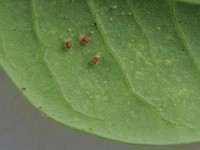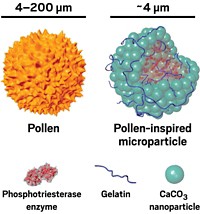Advertisement
Grab your lab coat. Let's get started
Welcome!
Welcome!
Create an account below to get 6 C&EN articles per month, receive newsletters and more - all free.
It seems this is your first time logging in online. Please enter the following information to continue.
As an ACS member you automatically get access to this site. All we need is few more details to create your reading experience.
Not you? Sign in with a different account.
Not you? Sign in with a different account.
ERROR 1
ERROR 1
ERROR 2
ERROR 2
ERROR 2
ERROR 2
ERROR 2
Password and Confirm password must match.
If you have an ACS member number, please enter it here so we can link this account to your membership. (optional)
ERROR 2
ACS values your privacy. By submitting your information, you are gaining access to C&EN and subscribing to our weekly newsletter. We use the information you provide to make your reading experience better, and we will never sell your data to third party members.
Materials
Nanopollens pack a sticky antibacterial punch
Nanoparticles that mimic the rough surface of pollen grains boost the activity of an antibacterial protein
by Alla Katsnelson
June 2, 2016

Scientists are searching far and wide for tools to fight bacterial infection in the face of increasing levels of antibacterial resistance. Recent studies have tried to harness lysozyme, a naturally occurring protein that attacks bacterial cell walls, as an antimicrobial agent. But its activity is too low to breach the less permeable external membrane of gram-negative bacteria such as Escherichia coli and kill them.
Now, researchers have developed supersticky nanoparticles that can deliver lysozyme directly to bacteria, boosting the protein’s antibacterial potency (J. Am. Chem. Soc. 2016, DOI: 10.1021/jacs.6b00243). The nanoparticles mimic the spiky shape of pollen grains, which adhere onto insect legs by virtue of their rough outer surface, says Chengzhong Yu of the University of Queensland.

Nanoscience researchers have begun to explore the role that the surface morphology of porous nanoparticles plays in the ability to deliver drug molecules to cells, and most efforts to create such particles use surfactants to guide their growth. However, surfactants are costly on a large scale and provide limited options in terms of shapes, Yu says. He and his colleagues designed a surfactant-free, one-pot technique for making nanopollen particles from silica, a material designated as safe to eat by the Food & Drug Administration.
To manufacture the silica nanopollens, the researchers first created a polymer core and then deposited a layer of silica mixed with the same polymer on top of it. Then the polymer was burned out at high temperature, leaving a hollow silica particle with a spiky surface texture. Mixing the positively charged lysozyme with the negatively charged particles loaded the protein onto the particles via electrostatic interaction.

Then the researchers tested the stickiness and killing power of these nanopollens. When incubated with E. coli, almost 10 times as many nanopollen particles adhered to the bacteria as smooth silica nanoparticles. At a lysozyme concentration of 700 μg/mL, nanopollen particles completely inhibited bacterial activity for three days in culture, whereas smooth particles or free-floating lysozyme failed to fully inhibit bacterial growth. In segments of rat small intestine, lysozyme-containing nanopollens reduced the E. coli count by more than 97% compared with smooth particles, and by 99% compared with free-floating lysozyme.
Using rough outer texture to create a particle that is supersticky toward E. coli is “a very unique and interesting idea,” says Thomas J. Webster, a chemical engineer at Northeastern University. However, he says that in his experience, the FDA generally seeks a 99.99 to 99.999% reduction in bacterial numbers for antimicrobial agents, so the nanopollen-carried lysozyme may not be sufficiently potent. Also, particles this size—almost 400 nm in diameter—would likely be recognized and cleared by the immune system. Still, the study is promising, he says. “They’re looking at a property that we’re only beginning to understand.”
Yu agrees that immune clearance would be a problem if particles were injected into the bloodstream, but not if delivered orally. His team plans to use the lysozyme-filled particles to create antibiotic-free animal feed to combat the problem of antibiotic overuse in factory farming. Because lysozyme is a natural enzyme secreted in tears, saliva, and stomach mucus, it is stable under the acidic conditions in the stomach. The group has patented the approach and will soon test their lysozyme-nanopollen formulation in live chickens to see if it helps the birds grow faster. Yu says that the nanopollens could also have many other applications, such as delivery vehicles for pesticides applied to plants or animal fur.





Join the conversation
Contact the reporter
Submit a Letter to the Editor for publication
Engage with us on Twitter